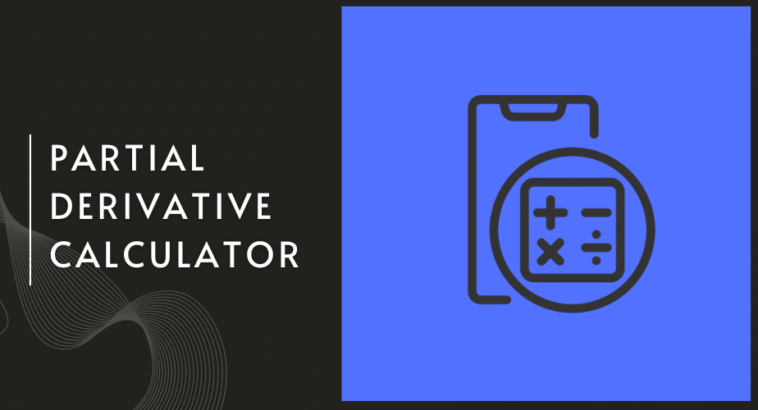The rate at which a function changes in relation to one variable while holding the other variables constant is represented by a partial derivative. It is a fundamental idea in multivariable calculus that is necessary for examining functions that involve multiple independent variables. This procedure is automated by a partial derivative calculator, which produces precise results immediately.
Manual calculation of partial derivatives can be time-consuming and prone to errors, especially with complex equations. A derivative calculator simplifies the process, enabling students, engineers, and data scientists to get accurate derivatives with minimal effort. Compared to traditional differential calculators, this tool specializes in functions involving multiple variables.
Partial derivatives are crucial in fields like physics, economics, machine learning, and engineering. For example, they help model fluid flow, optimize multivariable systems, and train AI algorithms. Having access to a derivative calc that handles partials efficiently is a game-changer for technical professionals.
Key Features of an Effective Partial Derivative Calculator
User-Friendly Interface
The best derivative calculators offer clean, intuitive interfaces. Whether you’re entering a function like f(x, y) or a more complex multivariable expression, these tools guide you through input formatting and selection of variables.
Support for Multiple Variables
An advanced differential calculator can manage functions with several variables, offering step-by-step breakdowns. For instance, entering f(x, y, z) allows you to compute ∂f/∂x, ∂f/∂y, or ∂f/∂z with a single click.
Symbolic vs. Numeric Output
Numerous contemporary derivative calculation tools offer numerical results (for certain input values) or symbolic differentiation (in algebraic form). For users working with both theoretical and practical applications, this flexibility is crucial.
How a Derivative Calculator Works
Input and Variable Selection
You begin by entering the multivariable function into the derivative calculator. Most tools allow easy variable selection using dropdown menus or simple syntax.
Backend Computational Engine
Once the input is set, the calculator applies multivariable differentiation rules—like the chain rule or product rule—to derive the result. This mimics what a differential calculator would do manually, but much faster.
Step-by-Step Solutions
Premium versions of these calculators offer detailed solutions, showing each step of the derivative calculation. This helps students learn the theory while using the derivative calc as a teaching tool.
Comparing Derivative Calculators to General Derivative Tools
Function-Specific vs. General Derivation
A derivative calculator specializes in multivariable functions, while a general derivative calc may only handle single-variable cases. This distinction matters when working with complex models.
Output Accuracy and Depth
Compared to a basic differential calculator, a partial derivative tool provides more granular and accurate results for functions with several variables, offering insights into directional changes and gradient fields.
Learning Support
While most derivative calcs provide final answers, partial calculators often offer educational support with breakdowns, making them more useful for beginners and learners.
Applications of Partial Derivatives in Real Life
Physics and Engineering
In thermodynamics or fluid mechanics, partial derivatives model temperature changes and pressure distributions. A derivative calculator helps visualize how one variable impacts the system, while keeping others fixed.
Economics and Business
Economists use partial derivatives to determine marginal cost, revenue, or utility. Using a derivative calc tailored to this need streamlines decision-making processes.
Machine Learning and Data Science
Gradients, computed using partial derivatives, are critical in training machine learning models. Automating this step with a differential calculator boosts accuracy and speed in developing AI systems.
Benefits of Using a Partial Derivative Calculator
Saves Time and Reduces Errors
Whether you’re preparing for exams or working on a real-world problem, a derivative calculator ensures precision and efficiency—key when dealing with intricate functions.
Enhances Learning and Understanding
Seeing step-by-step solutions helps users understand each differentiation rule. It functions not just as a derivative calc, but as a mini tutor for mastering multivariable calculus.
Access from Anywhere
Most calculators are available online and mobile-friendly. Unlike traditional differential calculators, you can access these tools anytime, anywhere.
Choosing the Right Derivative Calculator
Check for Multivariable Support
Ensure the derivative calculator supports functions with at least two or three variables and handles both partial and total derivatives.
Look for Step-by-Step Solutions
Educational tools should explain the process, not just the result. The right derivative calc should include learning support.
Verify Symbolic Engine Accuracy
A strong symbolic engine ensures algebraic accuracy. It distinguishes high-end tools from basic differential calculators that may round off or simplify incorrectly.
Common Mistakes When Using a Derivative Calculator
Incorrect Variable Selection
Always confirm the variable you’re differentiating with respect to. The derivative calculator will give different results for ∂f/∂x vs ∂f/∂y.
Improper Function Formatting
Most errors occur from syntax issues. Unlike basic derivative calcs, partial tools often require precise input—such as parentheses and commas—to parse functions correctly.
Ignoring Function Continuity or Differentiability
Some functions aren’t differentiable at all points. Even a robust differential calculator may struggle if the input doesn’t satisfy continuity conditions.
Best Online Tools for Partial Derivatives
Symbolab
Symbolab’s derivative calculator is intuitive, provides step-by-step results, and supports advanced multivariable functions. It’s a favorite among students and professionals.
Wolfram Alpha
Known for its computational power, Wolfram Alpha excels as a differential calculator and can solve partial, total, and directional derivatives efficiently.
CalculatorSoup and Mathway
These platforms offer clean interfaces and instant results, ideal for quick derivative calc tasks, with some support for multivariable differentiation.
Final Thoughts and Practical Advice
Why Every Math Learner Needs a Derivative Calculator
A derivative calc is more than a tool—it’s a learning companion. It simplifies complex math, provides accurate answers, and fosters better understanding of how variables interact in real-world systems.
Choosing Between Calculators
If your work involves single-variable calculus, a general derivative calc might suffice. But for any multivariable task, a specialized derivative calculator will offer the clarity and precision you need.
Stay Curious, Keep Practicing
Use your calculator as a bridge to deeper understanding, not a shortcut. Learn from each solution, compare with manual work, and explore new ways to apply partial derivatives in your field using a reliable differential calculator.




